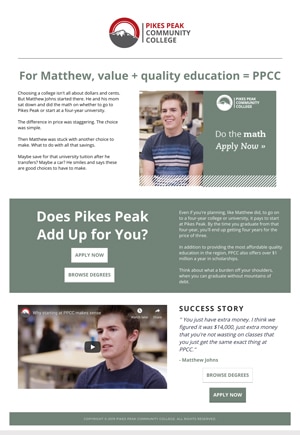How Digital Drove Record Increase In Applications For A Community College
A Changing Landscape
Getting To Know PPSC's Audience
PPSC complies with strict geography limitation in which to advertise. But opportunity can always be found, and step one in our strategy was to maximize it. Awareness is an important part of any marketing effort. It feeds everything that happens later on. Where awareness gets tricky, however, is the speed by which it can chew up budgets, not leaving enough for lower-funnel efforts. And the risk of “wasted impressions” is also why we emphasize a data-driven approach to simply casting a wide net. We found qualified prospects at the right time, addressing them with a message that targets, resonates, and compels. Once you do that, it’s important to have a plan to reach those prospects multiple times with tailored messaging. Just as important, though, is knowing when to pump the brakes. It’s a bit of a science—or at least a balancing act—to have a sense of pushing harder to seal the engagement, or backing off to avoid over-saturating and irritating prospects. Mapping the possible journeys for each audience persona helped us dive deep into each segment’s media consumption habits and evaluate the best awareness opportunities for each. Based on the informed findings, we aligned each journey with relevant messaging and platforms. Being well-equipped with a variety of messages to serve and proper tracking in place, we knew precisely how many impressions and touch points were necessary to engage for the first time, followed by how many more interactions were needed to start the application process.


Assets and Insights to Scale Efforts
Following the carefully segmented audiences and mapped out journeys, we developed assets and landing pages for each awareness campaign. The effort it took to build out the multiple scenarios allowed us to plan the execution and alignment of a variety of messages, from purely text based ads to graphics, to video. Why is the variety necessary? Users do very specific things within their specific journeys. They each have unique pain points, which means unique mindsets. They utilize different platforms. They consume different types of media, at different times of day. The things we were learning about PPSC’s audiences allowed us to use real-time modeling and prospecting to scale efficiently. And most importantly, we knew with pinpoint accuracy, that no one would see irrelevant messages or boring media.



